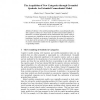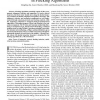92 search results - page 18 / 19 » A Simulation Environment for Middle-Size Robots with Multi-l... |
KESAMSTA
2010
Springer
14 years 1 months ago
2010
Springer
Abstract. In Multi-Agent System, observing other agents and modelling their behaviour represents an essential task: agents must be able to quickly adapt to the environment and infe...
ICANN
2003
Springer
14 years 1 months ago
2003
Springer
Abstract. Solutions to the symbol grounding problem, in psychologically plausible cognitive models, have been based on hybrid connectionist/symbolic architectures, on robotic appro...
INFOCOM
2009
IEEE
14 years 3 months ago
2009
IEEE
—Tracking mobile targets using sensor networks is a challenging task because of the impacts of in-the-filed factors such as environment noise, sensing irregularity and etc. This...
TFS
2008
13 years 8 months ago
2008
Abstract--Flocking algorithms essentially consist of three components: alignment, cohesion, and separation. To track a desired trajectory, the flock center should move along the de...
ATAL
2010
Springer
13 years 9 months ago
2010
Springer
Learning, planning, and representing knowledge in large state t multiple levels of temporal abstraction are key, long-standing challenges for building flexible autonomous agents. ...


